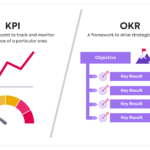
Introduction: OKRs (Objectives and Key Results) are a powerful tool for driving focus, alignment, and accountability within organizations. However, like any framework, the success of OKRs depends on proper implementation and execution. Many organizations struggle with common pitfalls that can undermine the effectiveness of their OKRs. In this blog, we’ll explore the most frequent mistakes companies make when implementing OKRs and provide actionable tips to help you avoid them.

1. Setting Too Many Objectives
The Mistake: One of the most common mistakes is setting too many objectives at once. When organizations try to achieve multiple goals simultaneously, it dilutes focus and makes it challenging to prioritize efforts. This often leads to mediocre results across the board, rather than exceptional outcomes in key areas.
How to Avoid It:
- Limit the Number of Objectives: Focus on 3-5 primary objectives per quarter. This ensures that your team can devote sufficient time and resources to achieving them.
- Prioritize Ruthlessly: Identify the most critical objectives that will drive the most significant impact on your organization’s goals. Encourage teams to concentrate on these priorities.
2. Creating Vague or Unclear Objectives
The Mistake: Objectives that are vague, ambiguous, or not well-defined can lead to confusion and misalignment within teams. If people are unsure of what the objective actually means, it becomes difficult to execute and measure progress effectively.
How to Avoid It:
- Make Objectives Specific and Actionable: Ensure that each objective clearly articulates what you aim to achieve. Use simple and direct language that everyone can understand.
- Align Objectives with Strategic Goals: Ensure that your objectives are aligned with the company’s overall strategy and mission. This clarity helps teams understand the purpose behind the objectives.
3. Setting Key Results That Aren’t Measurable
The Mistake: Key Results are intended to be quantifiable measures of success. However, many organizations set Key Results that are too qualitative or difficult to measure. This makes it hard to track progress and determine whether the objectives have been achieved.
How to Avoid It:
- Focus on Quantifiable Outcomes: Ensure that each Key Result is measurable. For example, instead of “Improve customer satisfaction,” a better Key Result would be “Increase Net Promoter Score (NPS) from 40 to 60.”
- Use Clear Metrics: Define clear metrics or numbers for each Key Result. This could include percentages, dollar amounts, or specific completion milestones.
4. Not Regularly Reviewing and Updating OKRs
The Mistake: Some organizations set their OKRs at the beginning of the quarter and then forget about them until the end. This lack of regular review can lead to a disconnect between daily activities and long-term goals, resulting in missed opportunities to adjust and improve.
How to Avoid It:
- Hold Regular Check-Ins: Schedule weekly or bi-weekly check-ins to review progress on OKRs. These meetings can help identify roadblocks, adjust priorities, and ensure alignment across the team.
- Be Flexible: If circumstances change, don’t be afraid to adjust your OKRs. The framework is meant to be dynamic, allowing for agility and adaptation.
5. Setting Objectives That Are Too Easy or Too Hard
The Mistake: Setting objectives that are either too easy or too ambitious can both be problematic. Objectives that are too easy fail to inspire growth or innovation, while objectives that are too difficult can demotivate teams and lead to burnout.
How to Avoid It:
- Aim for a Balance: Strive to set objectives that are ambitious yet achievable. The goal should be to challenge your team, but not to the point of frustration.
- Encourage Stretch Goals: Consider incorporating stretch goals—targets that are challenging but attainable with extra effort. This can motivate teams to push beyond their comfort zones.
6. Failing to Align OKRs Across the Organization
The Mistake: OKRs are most effective when they are aligned across all levels of the organization. If different teams or departments set OKRs in isolation, it can lead to conflicting priorities, duplication of effort, or missed opportunities for collaboration.
How to Avoid It:
- Ensure Top-Down Alignment: Start by setting high-level company OKRs, then cascade these down to department and team levels. Each team’s OKRs should align with and support the organization’s overall objectives.
- Encourage Cross-Functional Collaboration: Facilitate communication between teams to ensure that their OKRs complement rather than compete with each other. This fosters collaboration and a unified approach to achieving goals.
7. Ignoring the “Why” Behind OKRs
The Mistake: When employees don’t understand the purpose behind OKRs, they may see them as just another task or box to check off. This lack of understanding can lead to disengagement and a lack of enthusiasm for achieving the objectives.
How to Avoid It:
- Communicate the Bigger Picture: Make sure everyone in the organization understands the “why” behind the OKRs. Explain how achieving these objectives will contribute to the company’s mission and vision.
- Involve Teams in the Process: Encourage teams to participate in the OKR-setting process. When employees feel ownership over their goals, they are more likely to be motivated to achieve them.
Conclusion
OKRs are a powerful tool for driving organizational success, but they must be implemented thoughtfully and strategically. By avoiding these common mistakes—such as setting too many objectives, creating vague goals, or failing to align across teams—you can maximize the effectiveness of your OKR process. Remember, the key to success lies in clarity, focus, and regular review. With the right approach, OKRs can help your organization achieve ambitious goals and drive continuous improvement.




